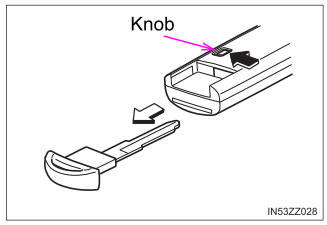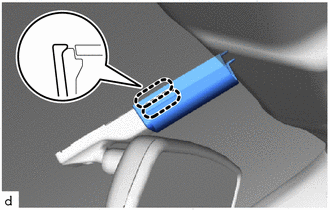Toyota Yaris: Inner Rear View Mirror / Removal
REMOVAL
PROCEDURE
1. REMOVE INNER REAR VIEW MIRROR STAY HOLDER COVER (w/o Pre-collision System)
(a) Slide the inner rear view mirror stay holder cover to disengage the guides as shown in the illustration.
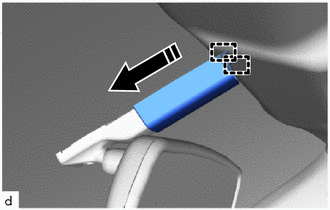
 | Slide in this Direction |
| (b) Disengage the claws to remove the inner rear view mirror stay holder cover. |
|
2. REMOVE NO. 2 FORWARD RECOGNITION COVER (w/ Pre-collision System)
Click here

3. REMOVE NO. 1 FORWARD RECOGNITION COVER (w/ Pre-collision System)
Click here

4. REMOVE INNER REAR VIEW MIRROR ASSEMBLY (w/o Pre-collision System)
(a) Disconnect the connector.

 | Remove in this Direction |
(b) Using a T20 "TORX" socket wrench, remove the screw.
(c) Remove the inner rear view mirror assembly as shown in the illustration.
5. REMOVE INNER REAR VIEW MIRROR ASSEMBLY (w/ Pre-collision System)
(a) Disconnect the connector.
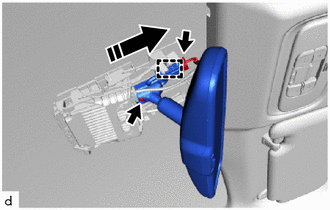
 | Remove in this Direction |
(b) Disengage the clamp.
(c) Using a T20 "TORX" socket wrench, remove the screw.
(d) Remove the inner rear view mirror assembly as shown in the illustration.
 Inspection
Inspection
INSPECTION PROCEDURE 1. INSPECT INNER REAR VIEW MIRROR ASSEMBLY (a) Inspect the operation of the electrochromic inner rear view mirror assembly.
*a Black Colored Tape *b Forward Sensor *c Bright *d Dark *e Auxiliary Battery *f AUTO Switch *g Component without harness connected (Inner Rear View Mirror Assembly) - - (1) Connect a positive (+) lead from the auxiliary battery to terminal 4 (IG) and a negative (-) lead to terminal 1 (E)...
 Installation
Installation
INSTALLATION PROCEDURE 1. INSTALL INNER REAR VIEW MIRROR ASSEMBLY (w/o Pre-collision System) (a) Install the inner rear view mirror assembly as shown in the illustration...
Other information:
Toyota Yaris XP210 (2020-2025) Reapir and Service Manual: Communication between ECUs connected by LIN Bus off (B278588)
DESCRIPTION This DTC is stored when LIN communication between the certification ECU (smart key ECU assembly) and steering lock ECU (steering lock actuator or upper bracket assembly) stops for 10 seconds or more. DTC No. Detection Item DTC Detection Condition Trouble Area B278588 Communication between ECUs connected by LIN Bus off No communication between steering lock ECU (steering lock actuator or upper bracket assembly) and certification ECU (smart key ECU assembly) for 10 seconds or more...
Toyota Yaris XP210 (2020-2025) Reapir and Service Manual: Front Brake Flexible Hose
ComponentsCOMPONENTS ILLUSTRATION *1 FRONT FLEXIBLE HOSE *2 GASKET *3 BRAKE LINE *4 FRONT SPEED SENSOR *5 UNION BOLT - - Tightening torque for "Major areas involving basic vehicle performance such as moving/turning/stopping": N*m (kgf*cm, ft...
Categories
- Manuals Home
- Toyota Yaris Owners Manual
- Toyota Yaris Service Manual
- Headlights
- Power Integration No.1 System Missing Message (B235287,B235587,B235787-B235987)
- Immobilizer System
- New on site
- Most important about car
Keys
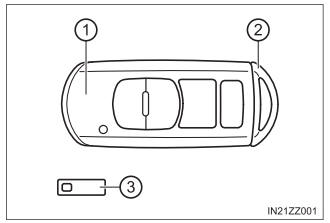
To use the auxiliary key, press the knob and pull out the auxiliary key from the smart key.
